Colac and district fauna : birds
Some commonly seen bird species found in the area, particularly around the
district's lakes.
Red necked avocet
Recurvirostra novaehollandiae
A water bird with long wading legs found swimming or wading on lakes
and mud flats across much of Australia.
It has a distinctive long upwardly curved bill. Reddish-brown head
and neck with white around the eyes. White body with thick black
stripes on the back and wings. Grows to about 45 cm in height. |
|
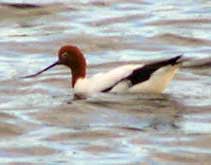
Public domain image. |
Royal spoonbill
Platalea regia
A large, long-legged wading bird common to wetlands in southeastern
Australia, distinguished by its flat, spoonshaped bill. Its food
is aquatic life, and it nests in trees, marshes or reed-beds. The yellow-billed spoonbill, below, is also seen on the lake shores. |
|
 |
Yellow-billed spoonbill
Platalea flavipes
Slightly larger and less common than the royal spoonbill, with a pale yellow to off-white beak and legs. Both species can be seen singly or in small groups, feeding by sweeping their distinctive beaks through shallow water in search of food. |
|
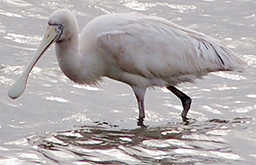 |
Purple swamp hen
Porphyrio porphyrio melanotus
The purple swamphen is widely distributed with minor variations
in temperate and tropical regions across much of the globe except
the Americas.
Preferring wetter areas, living in pairs or communities, feeding
on vegetation, invertebrates and small fish, they can fly clumsily
and swim well despite not having webbed feet.
Also commonly seen are coots, smaller hens with a similar profile, with dark grey plumage and a distinctive white bill and head shield.
|
|
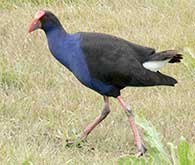 |

Australian pelican
Pelecanus conspicillatus
Widespread near large open areas of water in Australia, the South Pacific
and Indonesia and distinguished from other pelicans by their strong black-and-white
plumage. They fish in groups and are a magnificent spectacle skimming long
distances only inches above the water surface.
Vaughan Island, at the southern end of Lake
Corangamite, is one of the
few pelican breeding colonies in Victoria, as well as being home to ibis
and swans.
Pacific black duck
Anas superciliosa
One of a number of duck species found in the district, the
black duck is widely distributed across Australia and the south west
Pacific. Distinguished by its distinctive striped head.
Other commonly seen ducks are teals and the introduced mallard. |
|
 |
Large or great white egret
Ardea alba syn. Egretta alba
A tall, graceful water bird, up to one metre in height, with snowy
white foliage and orange beak, usually found alone, foraging in
shallow water on lakes in the district. It usually nests in colonies
near the water. Not to be confused with the white-faced heron described
below.
Length 76-92 cm. |
|
 |
White ibis
Threskiornis molucca
Also known as the black-necked ibis, sticklebill or sicklebird because of its long, curved bill, which distinguishes them from the royal spoonbill. Black head and tail plumage. Widespread across mainland Australia.
Length 68-76 cm.
|
|
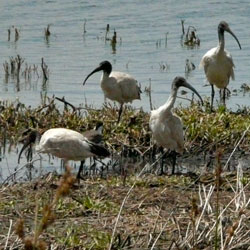 |
White-faced heron
Ardea novaehollandiae syn. Egretta novaehollandiae
A smaller close relative of the egret with similar posture, with
dull grey plumage, white face and yellow legs. Widely distributed
anywhere there is shallow salt or fresh water. The nest is an untidy
shallow bowl of sticks and usually on a leafy branch over or near
water.
Length 66-69 cm. |
|
 |
Black swan
Cygnus atratus
Distinctively Australian species of large nomadic waterfowl, common adjacent to water across most of the country apart from far inland, also introduced into New Zealand. Nest is a large heap of reeds and grasses, usually in shallow water. Although entirely black when swimming or walking, white flight feathers are revealed in flight.
Length: 1-1.5m, wingspan 1.6-2m.
|
|
 |
Pied stilt
Himantopus himantopus
also known as the black-winged or white-headed stilt, longshanks or stiltbird
Length: 35–38 cm – a medium sized wading bird with distinctive black and white markings, long narrow black beak and long pink legs. Almost worldwide distribution in swampy areas, lake margins and dams. |
|
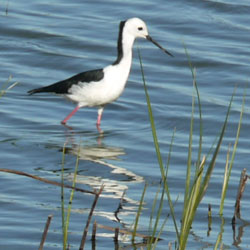 |
Masked lapwing
Vanellus miles
also known as the Spur-winged Plover, Alarmbird
Length: 33–38 cm – a medium sized bird with distinctive yellow mask,
wattle and beak. Characteristic ‘kekekek’ call, mainly at night.
May swoop when eggs or young are threatened. Nests in depression
on ground or flat grass.
Juvenile is black/brown mottled above. |
|
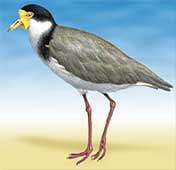 |











